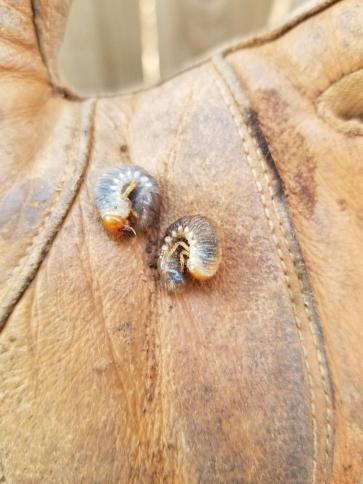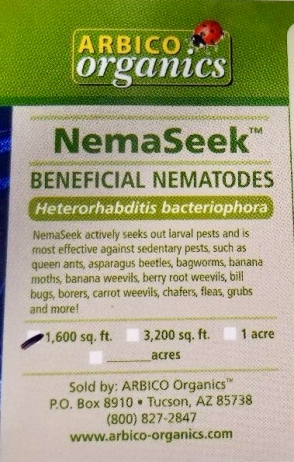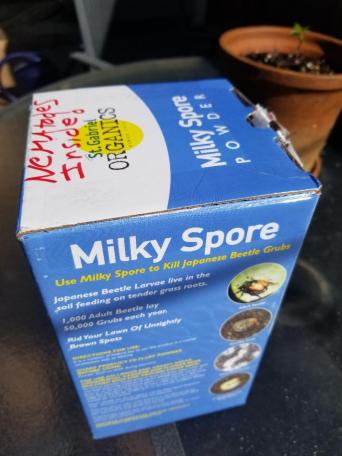
Hey y’all! Forgive me, but I’m gonna flashback a minute here. 🙂 Among the many lessons my mom has taught me about gardening I remember one of her first when I was around 6 or 7. I loved to dig holes, whether it was digging for buried treasure, tunneling to China, or just helping my mom plant. I remember finding earthworms and grubs and my mom telling me that we leave the earthworms to help our garden and throw the grubs to the chickens and birds because they will hurt our garden. So fast forward, I know now that an overabundance of grubs can cause some major damage to your root systems #theyrefavoritesnack. I also made a discovery a few weeks ago when I was weeding my garden and trying to break up some of the clay soil. These little a**holes are everywhere! In one shovel full of dirt I was pulling out 5-10 of these grubs. So in this post I’m going to address the solutions I’ve found to combat these grubs.
Grubs
Most of us have seen these little white grubs before, but what some don’t know is that these little guys are the larvae of Japanese beetles (aka June bugs), chafer beetles, and other scarab type beetles. I’ve haven’t noticed a big issue with these guys in the past, but this summer in Oklahoma for some reason we seem to have an overabundance of June bugs. This could be due to a number of reasons: weather, soil condition, and lack of predators. In small numbers these grubs aren’t necessarily harmful, but larger populations will eat root systems destroying lawns and gardens. If you find you have an overabundance of grubs there are several ways you can get rid of them by: increasing predator population, proper irrigation, or grub control products.
Predators
 Retrieved from https://bloody-disgusting.com/movie/3495747/predator-goes-hunt-cinemacon-first-footage-lots-bloody-action/
Retrieved from https://bloody-disgusting.com/movie/3495747/predator-goes-hunt-cinemacon-first-footage-lots-bloody-action/
Grubs have a lot of natural predators, but not all of them will be kind to your garden. Possums, armadillos, raccoons, and skunks all love grubs. However, they will tear up your garden searching for them and could destroy your plants in their search as well. Birds and chickens are a more viable option. But since I live in the suburbs, have a small backyard, and have prey driven dogs, chickens won’t really work for my solution. So attracting birds is one of the ways to help reduce my grub population. I already have a birdbath in my garden, but I will be adding a few birdhouses and even a small bird feeder to help attract them to my yard. Another great predator option I learned through some research is beneficial nematodes. Beneficial nematodes are microscopic worms that are usually found in gardens with healthy soil and help destroy grubs by seeking them out, entering their bodies, and releasing bacteria that kills the grub. They target only specific bugs that are harmful to your garden and are not harmful to your plants or pets. Unfortunately, with the state of my soil I don’t think I’ve been very helpful in promoting the nematodes. So, I’ve added some organic matter and bought some beneficial nematodes online from Arbico Organics for $36. I do not receive money, products, or benefit in any way from promoting this site and it’s products *though I wouldn’t mind it lol. 🙂 This was the most reputable site I found to purchase my nematodes. These are live creatures and if not shipped and stored properly they could die and not do a thing for your garden. Mine were properly shipped with an ice pack and I stored them in my refrigerator until I was ready to apply them. They are very easy to apply and come with helpful instructions. As long as you maintain a healthy garden you will continue to promote beneficial nematodes.

Irrigation
As I said before my soil hasn’t been in the best shape. I still have a good amount of clay that retains water and stays almost constantly moist. This not only promotes the growth of grubs but also isn’t a optimum environment for the beneficial nematodes I talked about earlier. Clay soil with poor irrigation isn’t great for most plants and is an indication of a lack of organic matter that earthworms love as well. So it sounds like a simple fix right…? Just add some compost or other soil amendment. Wrong! It is a workout! Especially if you have a lot of clay. If you love your garden be prepared to use some muscle. I amended my soil with compost by working it in with a shovel and hoe, but I’ll be looking into also getting a manual tiller to help the process as well. I’ll also be going back in again in fall to add some more compost or manure and mulch to prepare my garden for winter.
Other Grub Control Products
There are a lot of insecticides you can find at your local garden center that help control grubs. However, it took a lot of digging to find out the active ingredients used for some of the grub control products produced by Scotts and Bayer, and in my garden I prefer to use the most naturally occurring forms of pest control possible. But these products do work and if you need a fast, long acting solution they are a great option. In my garden I chose to use milky spore (also purchased from Arbico Organics for $29). Milky spore is a powder that contains bacteria that kills larvae of Japanese beetles only after the spore is ingested by the grub during normal feeding. It is not harmful to other animals, plants, or people. However, it’s not a quick solution. It can take several weeks or months for the spore to be established in the soil. In combination with birds, manual extraction, and the beneficial nematodes, which are all faster acting solutions, they can be a great natural ways to combat grubs.

Hope ya’ll enjoyed this post! Let me know if you have found other solutions to grub problems or if you have any questions. Thanks y’all! 🙂
I remember Mom saying that too and it has always stuck with me!
Loving the blog!!
LikeLiked by 1 person
Thanks MerMer!!!:)
LikeLike